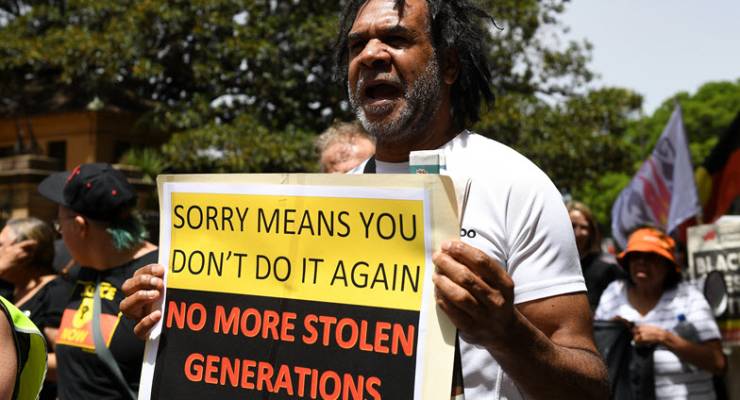
Five Aboriginal people have died in custody since early March. Since the landmark royal commission report into Aboriginal deaths in custody exactly 30 years ago, more than 500 Aboriginal and Torres Strait Islander people have died while in police care. The Commission examined 99 deaths in custody and found of those people, 43 were removed from their families as children.
The connection between experiencing the protection system as a child and incarceration as an adult has been known for decades. Yet Aboriginal children are still being removed from their families and culture at disproportionately high rates.
Between 2018 and 2019, about 18,000 Indigenous children were in out-of-home care. Aboriginal and Torres Strait Islander children are eight times as likely as non‑Indigenous children to have received child protection services.
‘Forever homes’ and history repeating
The language used to decide the fate of Aboriginal children, such as “best interests” and “permanency”, often has distinct meanings to Indigenous people. Children’s safety is still the priority over other factors. But what might be in the best interests of the child in the eyes of a judge or the NSW Department of Communities and Justice (DCJ) is likely to be different to best interests from an Aboriginal community perspective.
When child protection legislative reforms were introduced in NSW in 2018, experts and Aboriginal community members feared history repeating. The reforms’ focus on legal permanency and finding children a “forever home” promoted the adoption of children from care, leading to increases in adoption or guardianship orders, and the permanent legal severing of children from their families.
Most DCJ resources go to out-of-home care service provision instead of early intervention, prevention and restoration, and there are significant barriers that lead to lower rates of restoration for Aboriginal families. NSW law says restoration should be the first permanency option but that isn’t always happening.
It takes a village
The community workers, mothers, grandmothers, fathers and aunts who took part in my study explained that Aboriginal parents and families want Aboriginal kids to be just as safe as all children.
To achieve permanency, they said, children need to know who they are, where they are from and who their mob is. That meant children staying safely within their own family and community, with the support of the extended family and of the right services. To ensure their children’s and grandchildren’s wellbeing and safety, they try to bring up their children to have a positive sense of their Aboriginal identity, to be grounded in culture and have a sense of belonging and connection.
Those in my study, most of whom were women, told me it is common in Aboriginal families to “share care”. For example, aunts and a grandmother might look after the kids, providing love and care even if mum and dad already provided good-quality care. This helps strengthen the child’s bonds with multiple family members, not just mum and dad.
This might be because the parents work a lot or are experiencing personal problems. The child will often see their aunts or grandmothers as a mum; multiple family members’ homes are their own homes and places of safety, where they belong and can remain a part of their family networks. This does not mean the children are neglected or experiencing instability; it just meant there were many family members looking out for them.
The effect of alienation
Those who took part in my study said they wished DCJ and the Children’s Court would think “outside the box” to find solutions for Aboriginal children who were unsafe and in need of care. They wished Aboriginal children didn’t have to be placed with strangers with a different culture and way of life, where they might feel like they didn’t belong. They attributed this sense of alienation as a catalyst for problems later on in life, including mental health, parenting and relationships issues, and even incarceration.
Involving family decision-makers, such as grandparents and other elders or respected people in the family, in outcomes for kids is important: they know where it’s safe for children to stay and what’s needed to support family members to take on a child’s care. By thinking laterally and supporting families to share care, DCJ and Children’s Court judges could avoid the problem of “a lack of Aboriginal carers” that is often cited for placing kids outside their own extended family and community networks.
These are just some of the ways to achieve true permanence and look after the best interests of Aboriginal children in need of care. Permanence is not a piece of paper: permanence means solid relationships and connection to place and culture. The best interests of the child mean safety first, and for Aboriginal children to be truly safe, they need to remain a real part of their family and culture, which needs to be more than just going to NAIDOC Day events or watching Indigenous TV.
In these ways, Aboriginal children could feel genuinely safe, connected and protected, and families, services and the courts could help prevent them from crossing over into the justice system.
Wendy Hermeston an Indigenous academic and former Link-Up caseworker connecting members of the Stolen Generations with their families.







Crikey encourages robust conversations on our website. However, we’re a small team, so sometimes we have to reluctantly turn comments off due to legal risk. Thanks for your understanding and in the meantime, have a read of our moderation guidelines.